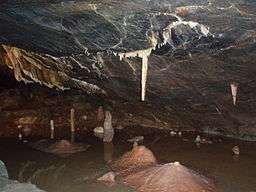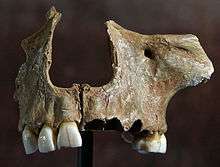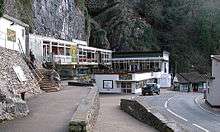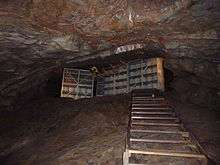Gough's Cave
Gough's Cave is located in Cheddar Gorge on the Mendip Hills, in Cheddar, Somerset, England. The cave is 115 m (377 ft) deep and is 3.405 km (2.12 mi) long,[2] and contains a variety of large chambers and rock formations. It contains the Cheddar Yeo, the largest underground river system in Britain.[3]
| Gough's cave | |
|---|---|
 Stalagmites and stalactites in Gough's cave | |
| Location | Cheddar |
| Depth | .90 m (300 ft) |
| Length | 2,135 m (7,005 ft) |
| Discovery | 1892 |
| Geology | Limestone |
| Access | Show cave open to the public; greater part by diving only |
| Cave survey | University of Bristol Spelaeological Society |
| Registry | Mendip Cave Registry[1] |
History
The initial sections of the cave, previously known as Sand Hole, were accessible prior to the 19th century.[4] Between 1892 and 1898 a retired sea captain, Richard Cox Gough, who lived in Lion House in Cheddar, found, excavated and opened to the public further areas of the cave, up to Diamond Chamber, which is the end of the show cave today. Electric lighting was installed in the show caves in 1899.[5]
The cave is susceptible to flooding often lasting for up to 48 hours, however in the Great Flood of 1968 the flooding lasted for three days.[6]
The extensive flooded parts of the cave system were found and explored between 1985 and 1990.[5]
Human remains and occupation

The cave contained skeletal remains of both humans and animals, all showing cut-marks and breakage consistent with de-fleshing and eating. Skull fragments represent from 5 to 7 humans, including a young child of about 3 years and two adolescents. The brain cases appear to have been prepared as drinking cups or containers, a tradition found in other Magdalenian sites across Europe.[7]
In 1903 the remains of a human male, since named Cheddar Man, were found a short distance inside Gough's Cave. He is Britain’s oldest complete human skeleton, having been dated to approximately 7150 BC.[8] His genetic markers suggested (based on their associations in modern populations whose phenotypes are known) that he probably had green eyes, lactose intolerance, dark curly or wavy hair, and, less certainly,[9] dark to very dark skin.[10][11]
The remains currently reside in the Natural History Museum in London, with a replica in the Cheddar Man and the Cannibals museum in the Gorge. Other human remains have also been found in the cave.

In 2010 further human bones from the cave were examined, which ultra-filtration carbon dating dated to around the end of the ice age 14,700 years ago. A second technique, using 3D microscopy, showed that the flesh had been removed from the bones using the same tools and techniques used on animal bones. According to Professor Chris Stringer of the Natural History Museum, this supports theories about cannibalism amongst the people living in or visiting the cave at that time.[12] In February 2011, the same team published an analysis of human skulls of the same date found at the cave around 1987,[13] which they believe were deliberately fashioned into ritual drinking cups or bowls.[14]
In 2020 a twenty centimetre long forty thousand year old mammoth tusk with a line of four holes drilled into it was interpreted as being a device for making rope. Grooves around each hole would have held plant fibres in place. The instrument was found near the base of the Aurignacian deposits at Hohle Fels by a team led by Nicholas Conard of the institute of archaeological sciences at the University of Tübingen. Veerle Rots, of the University of Liège in Belgium was able to make four twisted strands of twine, using a bronze replica of the Hohle Fels cave device, an example of Experimental archaeology. A similar 15,000 years old device, made of reindeer antler, was found in Gough's Cave. The existance of these tools a different locations indicates rope-making had already become an important human activity by the Upper Paleolithic. Chris Stringer Research Leader in Human Origins at the Natural History Museum said, “These devices were called batons and were originally thought to have been carried by chiefs as badges of rank. However, they had holes with spirals round them and we now realise they must have been used to make or manipulate ropes.” The ropes could then have been used to construct fishing nets, snares and traps, bows and arrows, clothing and containers for carrying food. Heavy objects, such as sleds, could now be hauled on ropes while spear points could be lashed to poles.[15][16]
Access and description

The first 820 m (2,690 ft) of the cave are open to the public as a show cave, and this stretch contains most of the more spectacular formations.[5] The greater part of the cave's length is made up of the river passage, which is accessible only by cave diving.
Beyond the show cave


Gough's cave contains long stretches of completely flooded river passage. From a point relatively close to the areas of the cave open to the public, the cave-divers' descent into Sump 1a begins through a tight passage known as Dire Straits. The bottom of that passage opens into the river passage, which is several meters across. This has been explored for 335 m (1,099 ft) downstream, whilst upstream a dive of 150 m (490 ft) brings the diver out in a 20 m (66 ft) long chamber named Lloyd Hall (which can now also be reached by an alternative, dry, route).[5][17]
Another dive of 140 m (460 ft) through Sump 1b, finishing with an ascent through a rising passage, leads to another chamber, 60 m (197 ft) long and 25 m (82 ft) wide at its widest point, and full of large boulders, called Bishop's Palace. This chamber is the largest chamber currently found in the Cheddar caves. Further on, three sump pools (named the Duck Ponds) lead to Sump 2 which is about 27 m (89 ft) deep at its lowest point and 150 m (492 ft) long.[5][17]
Air is again reached at Sheppard's Crook, which is followed by Sump 3. This sump is 55 m (180 ft) deep and at its bottommost point is about 30 m (98 ft) below sea level. Following Sump 3, a wide ascending passage continues for 370 m (1,214 ft) before reaching an impassable blockage, still below the water's surface.[5][17]
| Sump | Length of dive[5] | Depth[5] | Emerging into[5] |
|---|---|---|---|
| Sump 1a | 150 m (492 ft) | 18 m (59 ft) | Lloyd Hall |
| Sump 1b | 140 m (459 ft) | ? | Bishop's Palace |
| Sump 2 | 150 m (492 ft) with airbells | 27 m (89 ft) | Sheppard's Crook |
| Sump 3 | 370 m (1,214 ft) | 55 m (180 ft) | Passage blocked |
See also
References
- "Gough's Cave". Mendip Cave Registry & Archive. Retrieved 2012-03-30.
- "Gough's Cave". Mendip Cave Registry & Archive. Retrieved 2016-02-21.
- "Cheddar Yeo". Somerset Rivers. Retrieved 30 March 2010.
- Witcombe, Richard (2009). Who was Aveline anyway?: Mendip's Cave Names Explained (2nd ed.). Priddy: Wessex Cave Club. p. 83. ISBN 978-0-9500433-6-4.
- Irwin, David John; Knibbs Anthony J. (1999). Mendip Underground: A Cavers Guide. Wells: Bat Products. ISBN 0-9536103-0-6. – which also contains a detailed description of the cave.
- Donovan, D.T. (2006). "Gough's Cave, Cheddar, Somerset. Quaternary Stratigraphy" (PDF). Proceedings of the University of Bristol Spelæological Society. 24 (1): 17–35. Retrieved 24 February 2011.
- Bello, Silvia M.; Parfitt, Simon A.; Stringer, Chris B.; Petraglia, Michael (16 February 2011). "Earliest Directly-Dated Human Skull-Cups". PLoS ONE. 6 (2): e17026. doi:10.1371/journal.pone.0017026. PMC 3040189. PMID 21359211. Retrieved 24 November 2014.
- "Gough's Cave excavation". Natural History Museum. Archived from the original on 2009-07-27. Retrieved 2007-08-22.
- Walsh, S., Chaitanya, L., Breslin, K. et al. Hum Genet (2017) 136: 847. https://doi.org/10.1007/s00439-017-1808-5. Publisher Springer. Print ISSN 0340-6717 Online ISSN 1432-1203
- Brace, Selina; Diekmann, Yoan; Booth, Thomas J.; Faltyskova, Zuzana; Rohland, Nadin; Mallick, Swapan; Ferry, Matthew; Michel, Megan; Oppenheimer, Jonas; Broomandkhoshbacht, Nasreen; Stewardson, Kristin; Walsh, Susan; Kayser, Manfred; Schulting, Rick; Craig, Oliver E.; Sheridan, Alison; Pearson, Mike Parker; Stringer, Chris; Reich, David; Thomas, Mark G.; Barnes, Ian (18 February 2018), "Supplementary Material", Population Replacement in Early Neolithic Britain, bioRxiv 10.1101/267443, doi:10.1101/267443,
This individual has light or blue/green eye colour, it is not light blue, there are elements of brown/yellow in the eye to give a proposed perceived green colour. Better coverage at the low sequenced marker would clarify this but blue/hazel cannot be ruled out. It is certainly not a brown eyed or clear blue-eyed individual.
- "Cheddar Man FAQ". www.nhm.ac.uk. Retrieved 18 March 2018.
- McKie, Robin (2010-06-20). "Bones from a Cheddar Gorge cave show that cannibalism helped Britain's earliest settlers survive the ice age". The Guardian. Retrieved 20 June 2010.
- Bello, Silvia M.; et al. (February 2011). "Earliest Directly-Dated Human Skull-Cups". PLoS ONE. 6 (2): e17026. doi:10.1371/journal.pone.0017026. PMC 3040189. PMID 21359211. Retrieved 2011-02-17.
- Amos, Jonathan (2011-02-16). "Ancient Britons 'drank from skulls'". BBC News. Retrieved 2011-02-17.
- "Take a tusk, drill holes, weave a rope – and change the course of history". The Guardian. The Guardian. 1 August 2020. Retrieved 1 August 2020.
- "Archaeologists Find 40,000-Year-Old Rope-Making Tool in Germany". Sci-News. Sci-News. 22 July 2020. Retrieved 1 August 2020.
- Thomas, Alan (1989). The Last Adventure. Wells: Ina Books. ISBN 1-869897-05-6. which contains a first-hand account of the exploration of the river passage by Richard Stevenson
External links
- "Gough's Cave". Mendip Cave Registry & Archive.
- Official website
- The Caves of Cheddar Gorge by Tony Oldham
- Bones from a Cheddar Gorge cave show that cannibalism helped Britain's earliest settlers survive the ice age, Robin McKie, The Guardian, 20 June 2010
- Silvia M. Bello, Rosalind Wallduck, Simon A. Parfitt, Chris B. Stringer. An Upper Palaeolithic engraved human bone associated with ritualistic cannibalism, August 9, 2017.